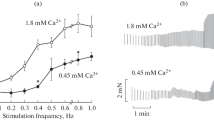Summary
-
1.
Inotropic action of g-strophanthin (1∶4,000.000), its dependence on stimulation frequency, and changes of two main factors determining the contractile force in relation to activity rate, „restitution” and „potentiation” effects, have been examined in isolated left auricles of guinea pig and rat.
-
2.
Evolution and extent of the positively inotropic effect of strophanthin in guinea pig auricles vary with the frequency of stimulation (fig. 1). The inotropic effect is inversely proportional to the initial basal amplitude, greatest at the rate of 30 p. min., and smallest at 120 p. min., its evolution being slowest at the low rate, and fastest at the high rate of activity.
-
3.
The diminution of contraction amplitude (both actual and proportional) after a shortening of the interval is smaller after strophanthin than before (fig. 2 and 3). The restitution effect thus is conspicuously augmented by the glycoside.
-
4.
The actual change in potentiation is small (fig. 2), its relative value decreases with strophanthin, owing to the increase in basal amplitude (fig. 3).
-
5.
In the guinea pig right atria the rate of spontaneous activity as well as the amplitude of contractions increase after strophanthin. Both changes, however, are not parallel (fig. 4). All effects of strophanthin in guinea pig auricles are reversible.
-
6.
In the rat atria all effects of strophanthin (1∶4,000.000) in identical experimental conditions are very small in opposite sense than in the guinea pig and mostly irreversible. The rat heart muscle with a very low faculty of potentiation has a singular position, and with regard to its contractility, cannot be considered as representative of the mammalian myocardium.
-
7.
Experimental analysis of the remarkably regular variations of the myocardial mechanical response in their relationships to stimulation frequency, provides a common basis for interpreting a number of known facts, and seems promising as a new approach in the investigations of pharmacological inotropic effects.
Zusammenfassung
-
1.
Es wurden die inotrope Wirkung des G-Strophanthin (1∶4,000.000), seine Abhängigkeit von der Stimulationsfrequenz, und die Veränderungen der zwei die Kontraktionsstärke in bezug zur Aktivitätsfrequenz, Restitution und Potenzierung bestimmende Hauptfaktoren, an isolierten linken Vorhöfen von Merrschweinchen und Ratten untersucht.
-
2.
Die Entwicklung und der Umfang der positiven inotropen Strophanthinwirkung an Meerschweinchen-Vorhöfen ändern sich mit der Stimulationsfrequenz. Sie ist der initialen Basalamplitude indirekt proportionell am größten bei 30, am kleinsten bei 120 Kontraktionen pro Minute, und entwickelt sich dabei am langsamsten bei den niedrigen und am schnellsten bei den hohen Kontraktionsfrequenzen.
-
3.
Die durch die Intervallverkürzung hervorgerufene Abnahme der Kontraktionsamplitude (wie absolut und relativ) wird durch Strophanthin kleiner. Der Restitutionseffekt wird so durch das Glycosid sichtbar vergrößert.
-
4.
Die aktuelle Veränderung der Potenzierung ist klein, ihr relativer Wert wird durch Strophanthin als Folge der Erhöhung der Basalamplitude verkleinert.
-
5.
Die rechten Vorhöfe der Meerschweinchen erhöhen durch Strophanthingaben sowohl die Frequenz ihrer Spontanaktivität als auch die Amplitude ihrer Kontraktionen; beide Veränderungen sind jedoch nicht parallel. Alle diese Strophanthinwirkungen sind reversibel.
-
6.
An den Vorhofpräparaten der Ratten ist unter den gleichen experimentellen Bedingungen die Strophanthinwirkung sehr klein, umgekehrt wie bei den Meerschweinchen und meistens irreversibel. Der Rattenherzmuskel hat durch seine sehr kleine Potentiationsfähigkeit eine sonderbare Stellung, und man kann ihn mit Rücksicht auf seine Kontraktilität nicht als den Repräsentanten eines Säugetierherzmuskels betrachten.
-
7.
Die experimentelle Analyse der merkwürdigen, regulären Variationen der mechanischen Herzmuskelantwort in ihrer Beziehung zur Stimulationsfrequenz setzt eine gemeinsame Basis für die Interpretation bekannter Faktoren voraus, und scheint als ein neuer Zutritt zu den Forschungen der pharmakologisch bedingten inotropen Effekte vielversprechend zu sein.
Similar content being viewed by others
Schrifttum
Benforado, J. M., J. Pharm. Exper. Ther.122, 86 (1958).
Bowditch, H. P., Ber. Kgl. Sächs. Ges. Wiss., math.-phys.1871, 654.
Bravený, P. andV. Kruta, Arch. Intern. Physiol.66, 633 (1958).
Furchgott, R. F., T. de Gubareff, andM. W. McCaman, J. Pharm. Exper. Ther.110, 19 (1954).
Garb, S., andM. Penna, Proc. Soc. Exper. Biol. Med.94, 18 (1957).
Hajdu, S. andE. Leonard, Pharm. Review11, 173 (1959).
Hollander, P. B. andJ. L. Webb, Circul. Res.3, 604 (1955).
Kelly, J. J. andB. F. Hoffman, Fed. Proc.17, 84 (1958).
Kisch, B., Handb. d. norm. u. path. Physiol.7/1, 712 (Berlin 1926).
Kruta, V., Arch. Intern. Physiol.45, 332 (1937);47, 35 (1938).
Kruta, V. andP. Bravený, Nature (in press).
Kruta, V. andR. Zadina, Arch. Internat. Pharmacodyn. Ther.59, 198 (1938).
Kruta, V., andJ. Stejskalová, Arch. Intern. Physiol.68, 152 (1960).
Lendle, L. andD. Oldenburg, Arch. Exper. Pathol. Pharm.211, 243 (1950).
MacDowall, R. J. S., A. F. Munro andA. F. Zayat, J. Physiol.130, 615 (1955).
Rosin, H., andA. Farah, Amer. J. Physiol.180, 75 (1955).
Sanyal, P. L. andP. R. Saunders, J. Pharm. Exper. Ther.122, 499 (1958).
Saunders, P. R. andP. L. Sanyal, J. Pharm. Exper. Ther.123, 161 (1958).
Scriabine, A., Pflügers Arch.269, 311 (1959).
Speirs, R. L., Nature184, 66 (1959).
Whalen, W., Science127, 468 (1958).
Wilbrandt, W., K. Braward, andP. N. Witt, Arch. Exper. Path. Pharm.219, 397 (1953).
Woodworth, R. S., Amer. J. Physiol.8, 213 (1902).
Author information
Authors and Affiliations
Additional information
Dedicated to ProfessorB. Kisch, M.D., on occasion of his 70 th birthday.
With 4 figures in 7 details
Rights and permissions
About this article
Cite this article
Kruta, V., Bravený, P. & Husáková, B. Dependence of the inotropic action of strophanthin on frequency and the postextrasystolic potentiation. Archiv für Kreislaufforschung 33, 63–72 (1960). https://doi.org/10.1007/BF02119759
Received:
Issue Date:
DOI: https://doi.org/10.1007/BF02119759




